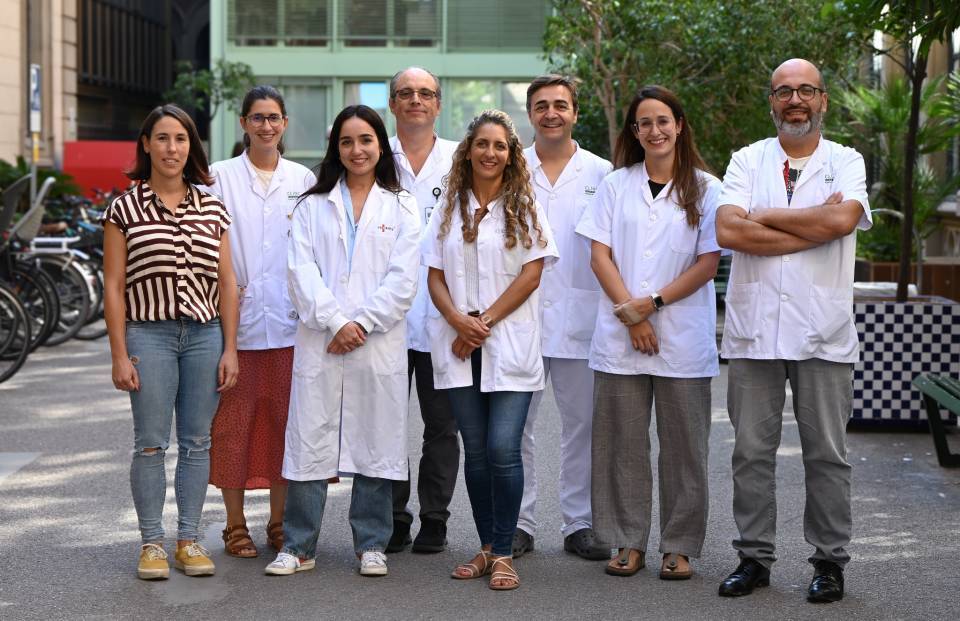In these studies, they have determined the peripheral immune profile of patients recently diagnosed with the disease and the differences between stable and progressive patients, and they have defined two subgroups of IPF patients according to the level of pulmonary infiltration. On the other hand, they have also determined the differences in the immune profile between patients with progressive and non-progressive pulmonary fibrosis.
The studies were coordinated by Dr. Jacobo Sellarés and Dr. Rosa Faner, researchers in the IDIBAPS Inflammation and repair in respiratory diseases group.
Pulmonary fibrosis encompasses a group of serious rare diseases in which the lung tissue becomes damaged and produces scars that replace the healthy tissue, resulting in a progressive deterioration of the lung function. The most common form is idiopathic pulmonary fibrosis, the cause of which is unknown.
Current antifibrotic treatments are not curative and only slow the progression of the disease, making it necessary to seek other therapeutic targets. In this respect, the role of the immune response in the fibrotic process is poorly understood.
Changes in the immune response in patients with idiopathic pulmonary fibrosis
The first study, published in the International Journal of Molecular Sciences, focused on the role of the immune response in the heterogeneity of idiopathic pulmonary fibrosis (IPF) and on determining its relationship with the severity and progression of the disease.
To test this, the blood of 32 patients with IPF was analysed and compared with 32 healthy age- and smoking-matched controls. The patients were followed up clinically for one year to determine their progression. At 18-60 months, the immune profiles in blood were characterized again.
“Most studies of immunological characterization in IPF have been carried out in patients at the end stage of the disease and, generally, in a cross-sectional manner. For this reason, we thought it would be very interesting to determine the immune profile at the time of diagnosis, and to see whether this initial profile could differentiate the patients who remained stable during the follow-up from those who progressed, despite the antifibrotic treatment ”, explains Núria Mendoza, first author of the study.
The results confirmed that people with IPF have a different cell profile from the controls. “There are anomalies in the innate and adaptive immune response, which are detected in the patients at the time of diagnosis, and that correlate with the severity of the lung function. These mainly occur in the cytotoxic cell domain and patients with IPF have more neutrophils, CD8+HLA-DR+ and CD8+CD28− T cells, and fewer B lymphocytes and naïve T cells, which help fight infections”, explains Jacobo Sellarés.
On the other hand, the presence of certain cells in the immune system in a sustained manner during the years of follow-up was related to the progression of the disease, despite treatment with antifibrotic drugs. “These patients who progress already show a characteristic immunophenotype at the time of diagnosis, which is maintained over time, despite antifibrotic treatment”, says Rosa Faner.
Further study of the immune profiles of patients with idiopathic pulmonary fibrosis
The second study published in the journal Respiratory Research, aimed to identify the heterogeneity in the immune response among patients with idiopathic pulmonary fibrosis at the end stage of the disease. Using transcriptomics to analyse the lung tissue of patients with fibrosis, it was possible to identify two subgroups with different immune signatures.
Two clusters of patients are identified with IPF with very different levels of immune signature in lung transcriptomics. There is one cluster of patients with a higher expression of immune signatures and another cluster with a higher expression of epithelial signatures.
The two groups have similar clinical characteristics at the end stage of the disease, just before transplantation. “It is possible that, at the initial stages, the clinical manifestations are different or that there are differences between the two groups in terms of the rate of progression, the frequency of relapses or the response to treatment”, points out Tamara Cruz, first author of the study.
“The results of the studies contribute to a better understanding of the role of the immune response in idiopathic pulmonary fibrosis, provide new prognostic biomarkers that may be useful in clinical practice, and expose new therapeutic targets for exploring future treatments”, conclude the authors.
Differentiating lung diseases based on the immune profile of patients’ peripheral blood
The third study, published in the journal Archivos de Bronconeumología, analysed whether the immune profile of peripheral blood differs between patients with progressive pulmonary fibrosis (PPF) and patients with non-progressive pulmonary fibrosis (non-PPF), in order to see what the relationship is with their clinical severity.
To do this, the immune profile was analysed in the peripheral blood of 33 patients with diffuse fibrosing interstitial lung disease at the time of diagnosis (11 patients with PPF and 22 patients with non-PPF). These patients were followed up for one year and were classified as stable or progressing according to the improvement in respiratory symptoms, radiological evidence of disease progression and/or a decline in forced vital capacity or decreased diffusing capacity for carbon monoxide. The immune populations at the time of diagnosis were compared between the two groups.
“What we observed is that the immune profile of peripheral blood in patients with fibrosing lung disease has common abnormalities and that an aged and exhausted immune profile is mainly associated with impaired lung function”, says Fernanda Hernández, first author of the study. Moreover, the immunophenotyping of patients with progressive pulmonary fibrosis suggests a cytotoxic immune response that correlates negatively with the lung function at the time of diagnosis.
Study references:
Mendoza N, Casas-Recasens S, Olvera N, Hernandez-Gonzalez F, Cruz T, Albacar N, Alsina-Restoy X, Frino-Garcia A, López-Saiz G, Robres L, Rojas M, Agustí A, Sellarés J, Faner R. Blood Immunophenotypes of Idiopathic Pulmonary Fibrosis: Relationship with Disease Severity and Progression. Int J Mol Sci. 2023 Sep 7;24(18):13832. doi: 10.3390/ijms241813832.
Cruz T, Mendoza N, Casas-Recasens S, Noell G, Hernandez-Gonzalez F, Frino-Garcia A, Alsina-Restoy X, Molina M, Rojas M, Agustí A, Sellares J, Faner R. Lung immune signatures define two groups of end-stage IPF patients. Respir Res. 2023 Sep 28;24(1):236. doi: 10.1186/s12931-023-02546-8.
Hernandez-Gonzalez F, Mendoza N, Casas-Recasens S, Cruz T, Albacar N, López-Saiz G, Alsina-Restoy X, Rojas M, Agusti A, Sellarés J, Faner R. Peripheral Immune Cell Profiling Reveals Distinct Immune Hallmarks in Progressive Pulmonary Fibrosis. Arch Bronconeumol. 2023 Oct;59(10):681-684. English, Spanish. doi: 10.1016/j.arbres.2023.06.009. Epub 2023 Jul 4. PMID: 37468400.




